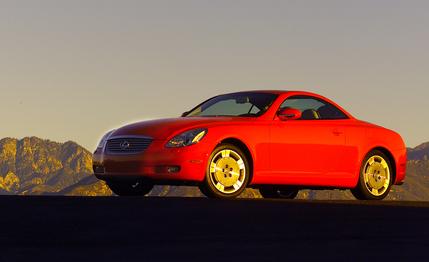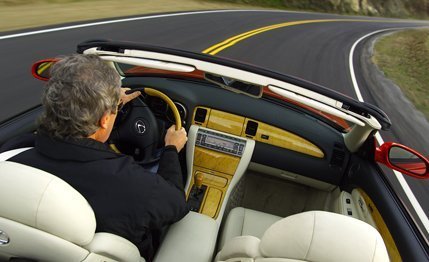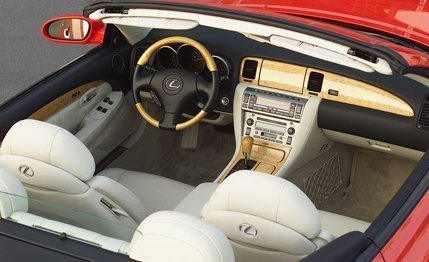 First Drive Review
First Drive Review


The chief engineer at Lexus, Yasushi Nakagawa, says the new SC430 design was inspired by the French Riviera. He sent the design team to the Côte d'Azur to check out the sights and sounds, and after they were dragged off the beach, the team sketched up this new convertible between espressos and bière pression. (That's draft beer to you, Bud boy.)
We're not sure what had the greatest effect, but this new SC430 turns out to be the biggest head turner we've driven all year. Head turner? Listen, in Los Angeles, drivers blitz through traffic like bank robbers to get alongside this car. And, as with the VW New Beetle and the Audi TT, these rubberneckers seem to think that drivers of visually expressive cars wish to converse with strangers at stoplights.
That's the downside. The upside is that you're driving a startling departure from what people have come to expect from the circle-L ranch in recent times. This car has a clear Italianate flavor derived, we thought, from the Riva powerboats that carve the cerulean waters of the Mediterranean. Nakagawa confirmed the suspicion: "Some of the character lines of the region's yachts are reflected in this car, replacing traditional wavy lines."

We're not sure what wavy lines he's referring to, but in some ways the volumes described by the stylist's pen are reminiscent of the Audi TT. See, despite the various accent lines, there's something tubular about the new SC430's profile.
But there's always some aspect of other cars in every new design until you become accustomed to its look. And the new SC430 is a terrific-looking car. It's an amazing departure from the sober--even derivative--designs typical of Lexus. In contrast, this one could almost be a concept car from an Italian carrozzeria at a Turin show.
If there's a quibble with this design, it's that the long wheelbase and the need for roof stowage have produced a long tail section, one that evokes Buick Riviera rather than French Riviera, and there's even a hint of GM EV1 in the downward contour. But we think the optional tail spoiler does a lot to mask the look. Moreover, we think the car looks better with the top up than with it down. That top is a fully automatic aluminum alloy structure that erects or stows itself in about 25 seconds, and it's much like the Mercedes-Benz SLK's roof in the way it folds up and stores. There's even a similar cargo cover that pulls out to reserve enough of the nine cubic feet of trunk space for the convertible top (it has to be slotted in place for the top mechanism to operate).

Many of the SC430's systems adapt themselves to the roof position. The climate-control system compensates automatically for top-down driving, and the nine-speaker stereo system has dual equalization levels for the same purpose.
The navigation system's display and the stereo control face have powered cover panels made of the same wood as the interior trim (either bird's-eye maple, as in our car, or the alternative burled walnut), and these deploy automatically when you lock the car with the top down. While on the move, or any time the top is up, the driver can manually select either covered or uncovered stereo and navigation controls.
This idea has led to the only piece of ergonomic mischief in this otherwise meticulous execution of design. To cover the stereo system, Lexus had to drop it down to the center console level. The layout would have worked better with the stereo up where the climate controls now reside. In fact, we frequently scanned the climate-control console for volume or station-scan buttons. Other than that the SC430 seems an unqualified success. Comfortable, fast, smooth, and quiet, the car offers all of the virtues expected in a patrician roadster. As usual with Lexus vehicles, the real challenge is explaining just how carefully noise, vibration, and harshness have been how effectively the airflow has been channeled, how immaculately the transmission action has been finessed.